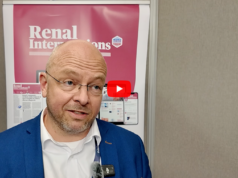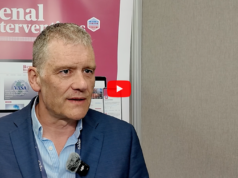
The recent haemodialysis access guideline update from the UK Kidney Association (UKKA), which was published in the run-up to the 2023 UK Kidney Week conference (UKKW; 5–7 June, Newport, UK), marks a considerable shift in how the organisation recommends that clinicians approach choices in vascular access for patients. Two of the UKKA update’s authors, Damien Ashby (Hammersmith Hospital, London, UK) and Catherine Fielding (University Hospitals of Derby and Burton NHS Foundation Trust, Derby, UK) spoke to Renal Interventions to detail how that shift was built on a desire to better consider the patient voice in all aspects of access care.
Asked what distinguishes this version of the UKKA guideline, Fielding began by highlighting the multidisciplinary involvement in the writing of the update. The text of the guideline states that nephrologists, surgeons and radiologists were all involved—as well as nurses like herself. Explaining the reasoning behind this, Fielding said: “It sometimes feels like it is not those who perform procedures like cannulation who are writing the guidelines on them. I am not saying that they should not have their own perspectives, but it leads you to wonder how some guideline proposals can be put into clinical practice. I think that practical, pragmatic element comes strongly through in this guideline—so that it is not just doctors but other professions that can implement it.”
Not only were a variety of specialties included, but there were also “three very active patient representatives” at the heart of the process. Developing this point, Ashby added: “The big thing that moves the needle with this guideline is how we constantly tried to involve the patient voice. The guideline emphasises different patient characteristics rather than just saying: ‘This is the best access for you.’”
Asked what might surprise some readers about the update, Ashby said that, though it would not surprise patients or nurses, it may be unexpected for some clinicians that the update does away with the concept of targets. Other guidelines, he suggested, prescribe fistulas as theoptimum form of access and provide a percentage of patients that should receive one. “It is not consistent with making the patient voice and patient choices the centre of care that hospitals should need to reach targets for types of access,” he argued. “We are moving away from that by recognising patient characteristics and what is sometimes the uncertainty of the evidence base.”
The patient voice is the fundamental difference in this guideline compared to both those issued by the UKKA in the past and those seen elsewhere, Ashby and Fielding agreed. Fielding also noted that the writing team contended with a “mushrooming” breadth of research in vascular access, which meant they were required to judge carefully what now warranted recommendation, and what still called for more research. In particular, however, they looked at qualitative data, something which they suggest may not have been included to the same degree in previous guidelines. “Once you start looking at studies of patient perspectives, it changes your own,” Ashby said.
The consideration of the patient perspective meant making the guideline more readable, too. Comparing the UKKA guideline with the Kidney Disease Outcomes Quality Initiative (KDOQI) guideline on vascular access, Ashby made the case that the references “running into the thousands” in the latter make it a comprehensive and impressive document, but one that is more of a challenge for readers. Part of the UKKA guideline team’s motivation was to provide information in a clear manner even to patients and carers, facilitating more informed decision-making.
On the content of the update itself, Ashby and Fielding concurred on a range of issues it addresses. “Timely treatment” of thrombosis, it suggests, is most effective—and it makes fistulas in particular more likely to work. Ashby highlighted that this is “an example of something where a better access outcome is also better for a patient’s experience […] which might even be a better reason to do it”.
The guideline has added a dedicated section on central venous stenosis (CVS) because, Ashby averred, “it is an important but maybe hidden problem that we wanted to highlight in the correct way”. Ashby advised, however, that the CVS recommendations are “not easy to summarise due to a complex and diverse literature”, and that the section demands more detailed reading. Ashby and Fielding concurred elsewhere also that an endovascular approach to many types of access dysfunction is “at least as good” as a surgical one. On new technologies such as drug-coated balloons, there was not sufficient existing evidence to make definitive recommendations, they said.
Queried on the potential consequences of giving patients an increased role in clinical decisions, Fielding stated that “actually putting all of the responsibility on the patient to make those decisions is very difficult”. However, she explained that the move towards shared decision-making is connected to a drive towards better informing patients, too. It is also about asking not only what is the best access from a clinician’s point of view, but taking a broader look at a patient’s life—and what kind of life they want to have after they receive their access.
“The other thing we have really highlighted through the guideline—and this is something both Damien and I are passionate about—is how important it is that the information we give patients is accurate and that we have interpreted the research accurately,” Fielding said. She further emphasised that it is vital that patients are informed of gaps in research, stating that “we should not be afraid” to tell patients when the literature is “ambiguous”. She also said that it is important to remember the “actual consequences to having a vascular access”, particularly on patients’ “day-to-day life”, referencing not only infection risk but also the “adverse effects of using it for haemodialysis”, such as cannulation pain.
Ashby concurred, saying: “It is not like giving someone a menu in a different language then asking what they want for dinner. You have got to help people to work out what those choices are and what they mean.” He drew a comparison with oncology, where he argued that cancer patients are often presented with a range of treatments, and he suggested that kidney disease patients should be offered similar “genuine choices” that reflect their needs and preferences. He referred to William Osler, who stated: “The good physician treats the disease; the great physician treats the patient who has the disease.”
Their concluding assessment of the guideline was that it “honestly summarises” the research in the field, “acknowledging uncertainties”. Most of all, they stressed its focus on the patient, while Fielding said that the full text of the guideline provides “very detailed rationales” for its suggestions. Both paid tribute to one of the patient representatives on the writing team who passed away during the writing process, which Ashby said served as a “big reminder” of the reality behind the recommendations. “For these people, it is their lives and their lifestyle. There is no way you can be doing this without remembering that this is all about a patient and their experience.”












